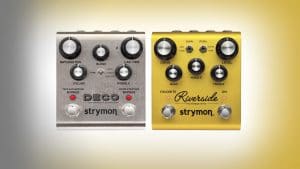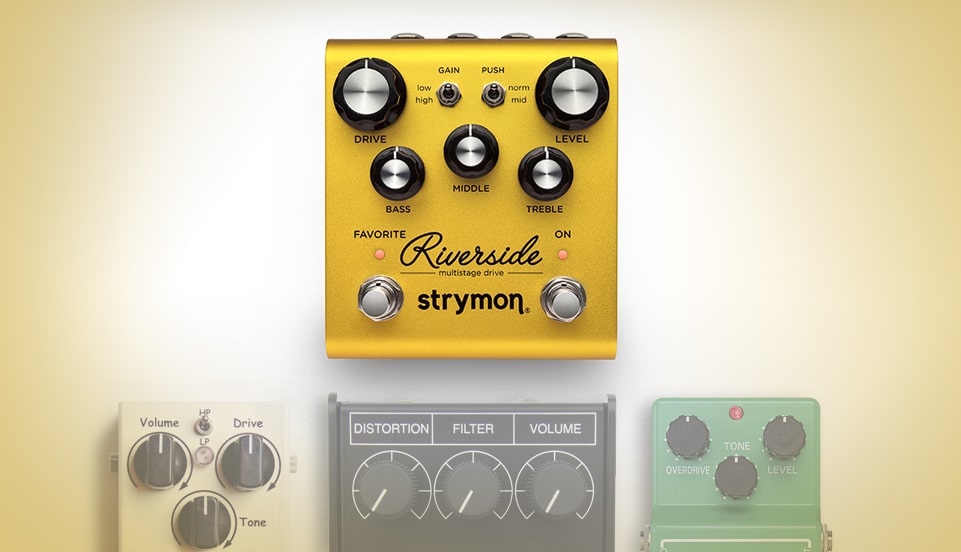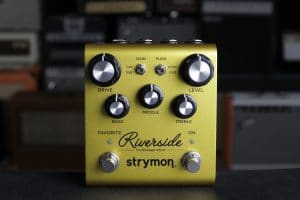
Riverside Drive and Deco Doubletracker – Video Demo
One of the things I really like about the Riverside Multistage Drive is its extremely wide range of harmonically complex drive sounds. Because of Riverside’s multistage topology, it goes
Free US Shipping On Orders Over $49
Easy 30-Day Returns
Financing Available Through ![]()

In the last few weeks, we have received quite a few questions about Riverside. Here are a few:
Is Riverside a tube screamer clone?
Is Riverside supposed to sound like an OCD?
Was Riverside designed to sound like a Rat?
The answer to those questions is no. We didn’t design Riverside with the intention of copying an existing overdrive circuit. The motivation behind Riverside was to create a drive pedal unlike those that have come before it. Rather than emulating an overdrive pedal, which typically consists of one or two diode clipping stages, Riverside’s sound, dynamics, and feel are like that of a multistage tube preamp with cascading gain stages. The clipping in these gain stages is based on the clipping characteristics of preamp tubes. The range of tone and type of sounds you can get with Riverside’s multistage topology is different than that of one or two stages of diode clipping.
Riverside’s inter-stage circuitry conditioning ensures an infinite sweet spot: As you turn Riverside’s Drive knob, continuously variable circuit tuning dynamically tweaks multiple parameters under the hood, tuning the circuit for optimum tone at any gain setting. So unlike any traditional overdrive pedal, using Riverside is really like adding a premium multistage tube preamp channel to your amp or signal chain, with a wide range of tones from sparking cleans and mild overdrives to high-gain leads and heavy saturated distortions. Riverside can be truly thought of as an “amp in a box” pedal.
Direct comparisons between Riverside and traditional drive pedals might be fun, but it’s really like comparing apples and oranges. (Or more accurately, diode clipping versus tube-style cascading gain stages)!
In many ways, I’d say there is room for both styles of overdrive on your board. If you love your vintage Tube Screamer, ProCo Rat, or Fulltone OCD, et. al, please do not rip it off your board thinking that Riverside is a direct clone of one of these fine drive pedals already on the market. In fact, in my bag of tricks I have found that Riverside plays nicely alongside traditional diode clippers. Try your Tube Screamer into a low-gain Riverside setting. Stacking that soft-clipper into Riverside’s “DSP tube” gain stages makes for some incredibly lush and tasty lead tones.
Though on the flip side, your ears may find that Riverside’s unique take on distortion and drive does warrant some shuffling on your board. Our goal was to ensure that Riverside could provide you with a new approach to the world of drive and distortions, with harmonically rich and tonally complex sounds that are primarily only found in fine tube amplifiers.
Happy driving!
Subscribe to our newsletter to be the first to hear about new Strymon products, artist features, and behind the scenes content!

One of the things I really like about the Riverside Multistage Drive is its extremely wide range of harmonically complex drive sounds. Because of Riverside’s multistage topology, it goes

We’re excited to announce that our new Riverside Multistage Drive pedal is now available! Riverside’s variable circuit tuning tweaks multiple parameters under the hood so that the

Thank you so much to everyone who came out to our fourth annual Strymon Social. This was the first year where we actually had two
5 Responses
Hi,
You say that it is more a preamp than a drive pedal. Then, how will it behave if plugged directly into a power amp? Cheers!
@Thibaut – It actually works great as a preamp directly into a power amp as this is how I use it in my own rig. 🙂
Thanks, good to know!
I really cannot wait to get a Deco and a second Riverside. I already have the big three Strymon’s and an OB.1, so my setup is almost complete!
Many don’t see the need for a Pre-Amp Pedal. I like the control I have over my amp at lower volumes. It’s not always practical to play loud. I love my Riverside with my Supro Saturn Reverb, I had no gain knob, so without a pre-amp pedal, the only way to get some breakup is with the volume knobs.
Also, I have Trio Band Creator at the end of my board that has a headphone jack, so with the Riverside, I can tailor the tone endlessly.
Great pedal.